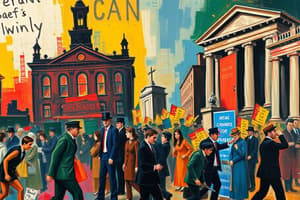Podcast
Questions and Answers
What event marked the end of the economic boom in the United States during the 1920s?
What event marked the end of the economic boom in the United States during the 1920s?
- The stock market collapse of 1929 (correct)
- The implementation of the New Deal
- The start of World War II
- The election of Franklin D. Roosevelt
Which program was NOT part of Franklin D. Roosevelt's New Deal?
Which program was NOT part of Franklin D. Roosevelt's New Deal?
- Works Progress Administration
- Social Security
- Federal Employment Agency (correct)
- Blue Eagle campaign
How did the government aim to reform the economy during the New Deal?
How did the government aim to reform the economy during the New Deal?
- By imposing regulations through the US Securities and Exchange Commission (correct)
- By reducing taxes on corporations
- By abolishing the stock market entirely
- By encouraging competition among banks
What was a significant outcome of the New Deal's relief programs?
What was a significant outcome of the New Deal's relief programs?
What major factor contributed to lowering unemployment levels in the US after the New Deal?
What major factor contributed to lowering unemployment levels in the US after the New Deal?
Flashcards are hidden until you start studying
Study Notes
Economic Boom and Collapse
- The 1920s marked an economic boom in the United States, characterized by a rapid increase in stock market investments.
- Many investors engaged in risky, speculative stocks, driven by optimism regarding continuous economic growth.
- The economic prosperity abruptly ceased in 1929, leading to a panic that caused a stock market collapse.
The Great Depression
- The stock market crash severely impacted the entire U.S. economy, resulting in high unemployment and a significant decline in production.
- The Great Depression initiated a widespread economic crisis, affecting millions of Americans.
Franklin D. Roosevelt and the New Deal
- Franklin D. Roosevelt was elected in 1932 amidst the Great Depression, advocating for the New Deal to combat the crisis.
- The New Deal comprised a series of programs aimed at immediate relief, economic recovery, and systemic reform to prevent future collapses.
New Deal Relief Programs
- The government offered aid to the unemployed, directly helping those in need.
- Social Security was established to support elderly citizens financially.
- The Public Works Administration (PWA) and Works Progress Administration (WPA) were created, providing millions of jobs by constructing infrastructure such as roads, bridges, and schools.
Economic Recovery Initiatives
- The National Recovery Administration (NRA) led the Blue Eagle campaign, pressuring employers to improve worker treatment and increase prices to stimulate economic growth.
- This initiative sought to ensure fair labor standards and stabilize industry practices.
Economic Reforms
- The New Deal included measures to reform the financial system, such as insuring bank deposits to restore trust in banking.
- The U.S. Securities and Exchange Commission (SEC) was established to oversee and regulate the stock market, reducing fraudulent practices and protecting investors.
Legacy of the New Deal
- Historians and economists widely recognize the New Deal as beneficial in reviving the U.S. economy.
- Full economic recovery and significantly lower unemployment were ultimately achieved due to increased production during World War II.
Studying That Suits You
Use AI to generate personalized quizzes and flashcards to suit your learning preferences.



